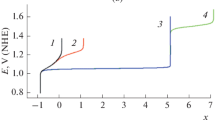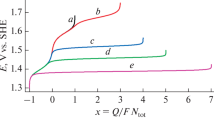Abstract
The changes in indicator-electrode potential and (quasi)equilibrium solution composition in the anodic compartment of a model electrolyzer initially filled with aqueous electrolyte containing 0.5 M concentration of bromide anions are calculated under the condition that pH 2 is maintained constant in this compartment. The theoretical analysis is carried out for three different hypotheses concerning the possible depth of electrolysis and the nature of processes involved: (1) no bromine compounds with positive degree of oxidation are formed; (2) bromine compounds with the degree of oxidation not higher than +1 are formed; (3) the process can involve the formation of both bromate ions and bromine compounds with the lower degrees of oxidation (\({\text{Br}}_{{\text{3}}}^{ - },\)\({\text{Br}}_{{\text{5}}}^{ - },\) Br2, BrO–, HBrO) in solution as well as the liquid phase of bromine \(\left( {{\text{Br}}_{{\text{2}}}^{{{\text{liq}}}}} \right).\) All electrochemical and chemical reactions involving bromine-containing species taken into account within the framework of hypotheses of system evolution 1, 2, and 3 are assumed to be (quasi)equilibrium, and the electric current through the cell separator is assumed to be provided by supporting electrolyte ions. Methods are proposed for experimental determination of the version of evolution of Br-containing anolyte during electrolysis.





Similar content being viewed by others
REFERENCES
Ferro, S. and De Battisti, A., The bromine electrode. Part I: Adsorption phenomena at polycrystalline platinum electrodes, J. Appl. Electrochem., 2004, vol. 34, no. 10, p. 981.
Ferro, S., Orsan, C., and De Battisti, A., The bromine electrode. Part II: reaction kinetics at polycrystalline Pt, J. Appl. Electrochem., 2005, vol. 35, no. 3, p. 273.
Ferro, S., The bromine electrode Part III: reaction kinetics at highly boron-doped diamond electrodes, J. Appl. Electrochem., 2005, vol. 35, no. 3, p. 279.
Bergman, ME.H., Iourtchouk, T., and Rollin, J., The occurrence of bromate and perbromate on BDD anodes during electrolysis of aqueous systems containing bromide: first systematic experimental studies, J. Appl. Electrochem., 2011, vol. 41, no. 9, p. 1109.
Osuga, T. and Sugino, K., Electrolytic production of bromates, J. Electrochem. Soc., 1957, vol. 104, no. 7, p. 448.
Vacca, A., Mascia, M., Palmas, S., Mais, L., and Rizzardini, S., On the formation of bromate and chlorate ions during electrolysis with boron doped diamond anode for seawater treatment, J. Chem. Technol. Biotechnol., 2013, vol. 88, no. 12, p. 2244.
Cettou, P., Robertson, P.M., and Ibl, N., On the electrolysis of aqueous bromide solutions to bromate, Electrochim. Acta, 1984, vol. 29, no. 7, p. 875.
Pavlovic, O.Z., Krstajić, N.V., and Spasojević, M.D., Formation of bromates at a RuO2/TiO2 titanium anode, Surf. Coat. Technol., 1988, vol. 34, no. 2, p. 177.
Conway, B.E., Phillips, Y., and Qian, S.Y., Surface electrochemistry and kinetics of anodic bromine formation at platinum, J. Chem. Soc., Faraday Trans., 1995, vol. 91, no. 2, p. 283.
Xu, J., Georgescu, N.S., and Scherson, D.A., The oxidation of bromide on platinum electrodes in aqueous acidic solutions: Electrochemical and in situ spectroscopic studies, J. Electrochem. Soc., 2014, vol. 161, no. 6, p. 392.
Johnson, D.C. and Bruckenstein, S., A ring-disk study of HOBr formation at platinum electrodes in 1.0 M H2SO4, J. Electrochem. Soc., 1970, vol. 117, no. 4, p. 460.
Grgur, B.N., Electrochemical oxidation of bromides on DSA/RuO2 Anode in the semi-industrial batch reactor for on-site water disinfection, J. Electrochem. Soc., 2019, vol. 166, no. 2, p. 50.
Petrov, M.M., Loktionov, P.A., Konev, D.V, and Antipov, A.E., Evolution of anolyte composition in the oxidative electrolysis of sodium bromide in a sulfuric acid medium, Russ. J. Electrochem., 2019, vol. 54, no. 12, p. 1233.
Mastragostino, M. and Gramellini, C., Kinetic study of the electrochemical processes of the bromine/bromine aqueous system on vitreous carbon electrodes, Electrochim. Acta, 1985, vol. 30, no. 3, p. 373.
Chang, J., Bennett, B., and Bard, A.J., Detection of an unstable intermediate in Br− electro-oxidation to \({\text{Br}}_{{\text{3}}}^{ - }\) on a platinum electrode in nitrobenzene by scanning electrochemical microscopy, Electrochim. Acta, 2017, vol. 238, no. 238, p. 74.
Allen, G.D., Buzzeo, M.C., Villagran, C., Hardacre, C., and Compton, R.G., A mechanistic study of the electro-oxidation of bromide in acetonitrile and the room temperature ionic liquid, 1-butyl-3-methylimidazolium bis(trifluoromethylsulfonyl)imide at platinum electrodes, J. Electroanal. Chem., 2005, vol. 575, no. 2, p. 311.
Bennett, B., Chang, J., and Bard, A.J., Mechanism of the Br–/Br2 redox reaction on platinum and glassy carbon electrodes in nitrobenzene by cyclic voltammetry, Electrochim. Acta, 2016, vol. 219, p. 1.
Petrov, M.M., Konev, D.V., Kuznetsov, V.V., and Antipov, A.E., Electrochemically driven evolution of Br-containing aqueous solution composition, J. Electroanal. Chem., 2019, vol. 836, p. 125.
Kelsall G.H., Welham N.J., and Diaz M.A., Thermodynamics of Cl–H2O, Br–H2O, I–H2O, Au–Cl–H2O, Au–Br–H2O and Au–I–H2O systems at 298 K, J. Electroanal. Chem., 1993, vol. 361, no. 1–2, p. 13.
Field, R.J. and Forsterling, H.-D., On the oxybromine chemistry rate constants with cerium ions in the Field‑Koros‑Noyes mechanism of the Belousov–Zhabotinskii reaction: The equilibrium HBrO2 + \({\text{BrO}}_{{\text{3}}}^{ - }\) + H+ – \({\text{2BrO}}_{{\text{2}}}^{*}\) + H2O, J. Phys. Chem., 1986, vol. 90, no. 21, p. 5400.
Kshirsagar, G. and Field, R.J., A kinetic and thermodynamic study of component processes in the equilibrium 5 HOBr = 2Br2+ \({\text{BrO}}_{{\text{3}}}^{ - }\) + 2H2O + H+, J. Phys. Chem., 1988, vol. 92, no. 25, p. 7074.
Gyorgyi, L., Turanyi, T., and Field, R.J., Mechanistic details of the oscillatory Belousov-Zhabotinskii reaction, J. Phys. Chem., 1990, vol. 94, no. 18, p. 7162.
Alves, W.A., Téllez, C.A., Sala, S.O., Santos, P.S., and Faria, R.B., Dissociation and rate of proton transfer of HXO3 (X = Cl, Br) in aqueous solution determined by Raman spectroscopy, J. Raman Spectrosc., 2001, vol. 32, p. 1032.
Tarasevich, M.R., Sadkowsky, A., and Yeager, E., Oxygen electrochemistry, in Comprehensive Treatise of Electrochemistry, 1983, London: Plenum, p. 301.
Reier, T., Oezaslan, M., and Strasser P., Electrocatalytic oxygen evolution reaction (OER) on Ru, Ir, and Pt catalysts: A comparative study of nanoparticles and bulk materials, ACS Catal., 2012, vol. 2, p. 1765.
Funding
This study was supported by the Ministry of Education and Science of the Russian Federation (Agreement of September 26, 2017, no. 14.574.21.0150, UIS: RFMEFI57417X0150).
Author information
Authors and Affiliations
Corresponding authors
Ethics declarations
The authors state the absence of any conflict of interests.
Additional information
Translated by T. Safonova
This paper is dedicated to the 80th anniversary of Professor V.V. Malev who has made a considerable contribution into modern directions of electrochemistry.
Rights and permissions
About this article
Cite this article
Petrov, M.M., Konev, D.V., Antipov, A.E. et al. Theoretical Analysis of Changes in the Solution Composition during Anodic Electrolysis of Bromide. Russ J Electrochem 55, 1058–1067 (2019). https://doi.org/10.1134/S1023193519110120
Received:
Revised:
Accepted:
Published:
Issue Date:
DOI: https://doi.org/10.1134/S1023193519110120




